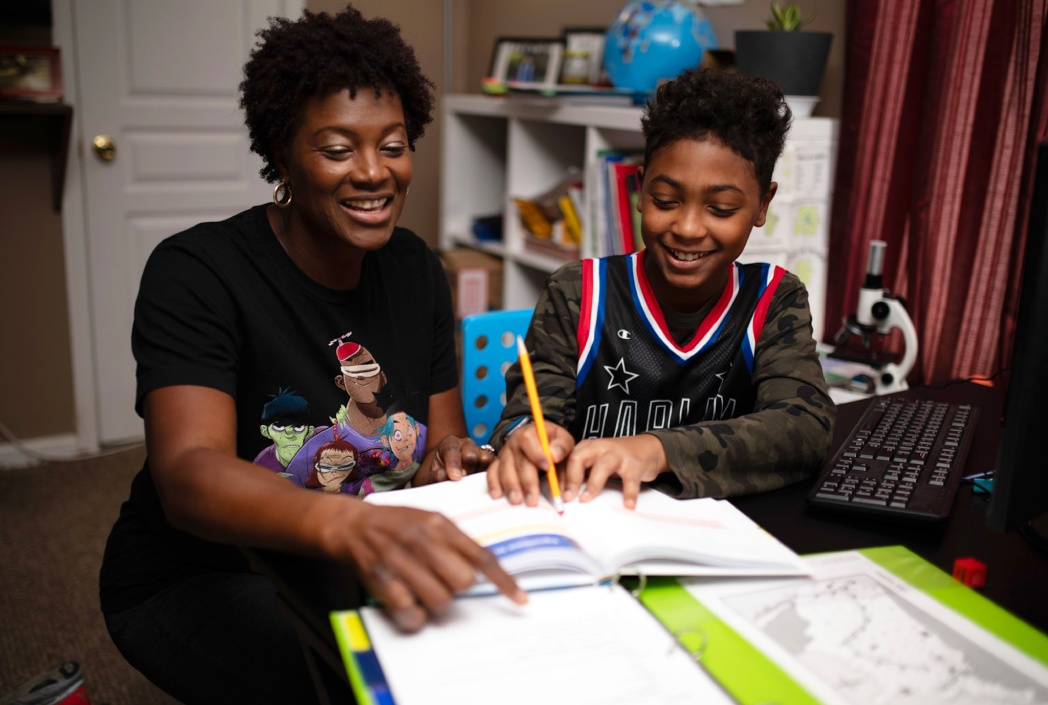Online vs. In-Person Classes: How K12-Powered Online School Stands Out
Discover how K12’s online learning stands out from traditional classrooms with flexibility, personalized instruction, and innovative tools.

Education today offers more choices than ever. Beyond traditional public and private schools, families can now choose online learning, charter programs, and hybrid models. Many parents ask the key question: Is online school better than in-person learning for my child?
At K12, we believe education should be flexible, engaging, and tailored to each child’s needs. Our online programs combine state-certified teachers, interactive learning tools, and a supportive community—giving students the best of both worlds.
This guide explores the differences between online vs. in-person classes, helping you make the best decision for your family.
Structure and Learning Environment
Structure and learning environment are all about how a school day is set up, including lesson schedules, teacher interaction, and the overall flow. In a traditional classroom, students follow a routine with fixed class times; online learning may still have set class times but offers more flexibility in when and how students can complete their assignments. That freedom can make a big difference for families who need a schedule that fits their lifestyle. Is online school better than in-person school? It depends, but it can be for many families, especially if a flexible, self-paced experience is what your child needs.
Part of the appeal of online learning is the ability to study from anywhere. At K12, students learn from home (or another safe place) with easy access to online tools, resources, and live virtual sessions led by state-certified teachers. This accommodates the needs of students who must learn outside regular school hours, while on the road, or who simply cannot attend classes in person. Online learning’s benefits include:
- Flexible Scheduling: Students can work with teachers to adjust the pace of lessons to match their needs. If your child struggles with math but speeds through reading activities, they can dedicate more time to challenging tasks and less to areas they’ve already mastered.
- K12’s Flex program extends this flexibility even further. Designed for families seeking a truly adaptable learning experience, Flex allows students to watch class recordings instead of attending live sessions and complete work on a timeline that fits their schedule. Students also receive continuous academic monitoring and teacher support.
- Individualized Instruction: Our teachers offer one-to-one support through video calls, phone, or email. Because of smaller virtual class sizes, they can personalize their approach to suit each student’s goals and tend to be more accessible.
Traditional classrooms must address the needs of as many students as possible in one go. This means they stick to a fixed school day schedule that works for most families, even if that may not be the best approach for all students. When comparing in-person vs. online learning, these things are often deciding factors:
- Fixed Timetables: The school day starts and ends at the same time each day, changing only as needed to accommodate school-wide or district needs—not the needs of individual students.
- Set Pace for Curriculum: Students proceed through specific topics at a pace determined by the school district or teacher, often leaving less room for customization.
Curriculum and Instruction
Put simply, curriculum is what students learn, the subjects they study, the materials they use, and the goals they work toward. Instruction is how that learning happens through teacher-led lessons, hands-on projects, or interactive activities. One of the biggest differences between online learning vs. in-person school is how these elements come together.
Online courses blend interactive technology with well-researched teaching methods. Our programs include multimedia lessons, virtual labs, and interactive tools that keep students engaged and provide them with instant feedback. This ensures each child’s educational journey is tailored to their unique learning style and needs. Teachers are also trained in virtual instruction, which can include:
- Customizable Plans: Our teachers tailor their approach to a student’s learning style and pace. If a child excels in one subject, we keep them challenged where needed without holding them back in other areas.
- Multimedia Lessons: Animations, simulations, and virtual labs offer a dynamic learning method, making challenging topics exciting to explore.
Traditional school structure follows a predictable routine, setting a rhythm for students to fall into. While this approach fosters socialization and real-time feedback, it doesn’t match the flexibility and personalized learning level that online programs can provide.
- Standardized Approach: Students move through units at the same pace as the entire class, often to achieve specific state standards. Lessons feature some degree of differentiation as teachers can, but they often don’t have time to fully adjust to each learner.
- Set Instruction Pace: Students typically receive material during set class times, which can limit the chance to revisit a concept later if they fall behind.
Teacher and Student Interaction
Are online classes as effective as in-person classes? That depends on many factors, including the teacher–student relationship. Teacher and student interactions shape the learning experience, from answering questions and giving feedback to building supportive connections.
At K12, we prioritize building strong, supportive relationships between students and teachers, even in a virtual setting. Our interactive online platforms create multiple connection opportunities, ensuring students—and parents—have the support they need. Online students enjoy:
- One-to-One Check-Ins: Students can contact teachers via video, chat, or phone for extra help or clarification outside of scheduled class times.
- Self-Directed Learning: Because students manage much of the assignment pacing (with guidance from teachers and parents), they learn to be proactive and organized.
In a physical classroom, students and teachers share space every day. This naturally results in direct interaction, fostering a relationship. However, the length of classes and number of students means this may not be as individualized as teachers would like. Brick-and-mortar environments allow for:
- Immediate Feedback: Students can raise their hands to receive real-time answers from teachers.
- Group Discussions: Classmates and teachers engage in direct face-to-face conversations, which promote quick problem-solving. This can happen in online classrooms, too, via chat features but may be less spontaneous.
Socialization and Extracurricular Activities
Extracurricular activities—clubs, sports, and creative projects—help students explore their interests beyond the classroom. One common question parents have when comparing online school vs. in-person school is how kids stay social in a virtual setting. While the experience differs from a traditional school environment, online students still connect with peers, collaborate on projects, and participate in group activities designed to build friendships and teamwork.
At K12, we understand that socialization and extracurricular involvement are vital parts of a well-rounded education. That’s why we’ve developed several ways for students to connect, have fun, and explore their interests with others, including:
- Virtual Clubs: Students can join online clubs focused on hobbies, leadership, community service, and other topics.
- Local Meetups: Schools sometimes organize in-person events. This allows students and parents to meet peers in person and forge strong friendships offline.
With in-person school, social interaction is organic. Young people socialize with classmates in the hallways, during lunch, while collaborating in the classroom, and through school events. They benefit from:
- Daily Peer Contact: Students interact face-to-face every school day, building friendships and communication skills.
- Structured Extracurriculars: Sports teams, drama clubs, and other activities happen right on school grounds.
Flexibility and Accessibility
Flexibility allows students to learn during times that work well for them and at their own pace. Accessibility ensures that every student can easily engage in their learning journey, regardless of location or specific needs. Online and in-person schooling both offer degrees of flexibility and accessibility, but they play out in different ways.
For many families, the flexibility of online learning offers a solution to challenges in-person schooling simply can’t accommodate. Whether managing a busy calendar or needing to adjust for unforeseen circumstances, online school provides the adaptability that works for a wide range of lifestyles. With K12, your child can continue their education without the stress of conflicting schedules for learning that is:
- Anytime, Anywhere: As long as you have internet, your child can attend classes, complete assignments, or connect with teachers.
- Ideal for Unique Schedules: Whether you have an athlete, performer, or child dealing with health issues, K12’s flexibility allows them to keep learning without missing important family or medical obligations.
Some find the stability and predictability of in-person learning comforting and better for their set schedules. This consistency creates a predictable rhythm for students to follow throughout the year and comes from learning with:
- Set Locations: There’s no question about where learning happens—it’s on campus, in familiar classrooms and facilities.
- Fixed Hours: The school day is the same for everyone, promoting consistent routines.
Parental Involvement
Another key factor in comparing online vs. in-person classes is the role parents play. Parental involvement is how families support their children, stay connected with their progress, and help guide their learning experience. In online learning, this role can look different from in-person education, offering unique opportunities for parents to be more directly engaged in their child’s education.
At K12, parents or guardians are essential Learning Coaches who actively participate in their child’s learning journey, offering structure and encouragement. This increased involvement lets parents stay closely connected with their child’s academic progress. Online learning offers parents:
- Active Guidance: Because our teachers work remotely, parents often help ensure their children follow the daily schedule, stay on track, and communicate regularly with teachers for assistance.
- Learning Coach Community: We encourage parents to join the Learning Coach Community for tips and shared experiences from other families.
In a conventional setting, parents still play an important role in a child’s education, though their involvement is typically more limited to after-school activities or periodic check-ins. Teachers and parents have more separated yet complementary roles:
- Teacher-Led Lessons: Trained educators lead instruction. Parents typically get involved only after classes end or during parent-teacher conferences.
- Homework Oversight: Parents assist with homework but may have less visibility into daily lessons.
Pace and Learning Style
When we talk about “pace” in a classroom, we mean how quickly or slowly students move through lessons. “Learning style” refers to how students process and understand information. Some learn best by reading, while others do better with hands-on projects or group discussions.
Many families consider online learning because students can work more at their own pace. Whether a student needs extra time or wants to explore advanced material, online learning offers:
- Personalized Speed: Students can quickly move through content they grasp or devote extra time to challenging subjects.
- Adaptable Lessons: Teachers can provide alternative assignments, readings, or projects to match different learning styles, such as visual, auditory, or hands-on.
With in-person settings, students move through at a standardized pace. Unfortunately, students who grasp concepts quickly may feel held back, while those who need more time might struggle to keep up.
Classroom Interaction
Classroom interaction refers to how students and teachers communicate and collaborate during lessons and how students engage with their peers. This interaction is key to how students absorb material, ask questions, and build relationships within the learning environment. Fostering strong communication helps students feel supported and engaged in their learning journey in both online and in-person settings.
Online programs, like those with K12, also focus on helping students connect—just in a virtual space. Teachers and students create a sense of community, even though they aren’t physically together, with the help of:
- Virtual Tools: Group video calls, discussion boards, and break-out rooms help students collaborate, ask questions, and engage in lessons, fostering meaningful connections.
- Flexibility in Communication: Shy students may find it easier to ask questions via chat, boosting participation for certain personalities.
In-person classrooms offer a clear advantage for direct physical interaction. Teachers can gauge students’ understanding through visual cues, and students have the opportunity to ask questions and participate. The classroom environment encourages:
- Immediate Social Context: Students see body language, facial expressions, and tone of voice more naturally.
- Spontaneous Collaboration: Quick group huddles, class discussions, and partner assignments unfold organically.
Technology Integration
Technology integration uses digital tools and resources to make learning more engaging and interactive. From virtual labs to educational apps, technology helps bring lessons to life in both online and in-person settings. It gives students new ways to explore subjects, stay engaged, and learn at their own pace.
Technology is front and center for families comparing in-person school to K12’s virtual model. Our online platform integrates digital tools, interactive lessons, and multimedia resources to enhance learning, making engaging students with the material easy. Students access:
- Main Learning Platform: Courses, lessons, and grades are accessed through a secure online system that students log into daily.
- Digital Resources: Videos, audio files, e-books, and interactive quizzes make lessons come alive.
Many brick-and-mortar schools integrate digital tools, too, but technology in the classroom can be limited and varies based on school and district.
5 Tips for Choosing Between Online and Traditional Learning
Are online classes as effective as in-person classes? With the right online school, they can easily be as effective, if not more so for certain students. However, no learning environment is right for every student. Parents should weigh the pros and cons and make the right decision for their child’s unique needs. Here are some tips to guide you as the one who knows them best:
- Consider Your Child’s Learning Style: Does your child do well with independent study? Are they comfortable with technology, or do they thrive in face-to-face discussions?
- Assess Social Needs and Extracurriculars: An in-person program might be more appealing if daily peer interactions or certain sports are top priorities. Online learners can join virtual clubs and local meetups, but it’s a different dynamic.
- Check for Accreditation: Whether you choose an online or in-person path, ensure the school has appropriate accreditation. K12-powered online schools are accredited, and the program aligns with state and national standards.
- Explore the Curriculums: Look for programs that fit your child’s interests. K12 offers core academic classes and specialized career and college prep options.
- Evaluate Support Services: Does the school provide counseling, academic coaching, or special education support? K12’s Learning Coach and teacher team system and teacher availability can significantly benefit students who need a helping hand.
Discover How K12 Can Support Your Child’s Success
K12 combines traditional education’s best elements with online learning’s flexibility and innovation. With accredited online schools, state-certified teachers, and tailored learning paths, K12 powers an engaging, high-quality alternative to brick-and-mortar schools.
Ready to take the next step? Explore our School Finder or contact us to learn more about how K12 can work for your family.
What's Your Reaction?


























